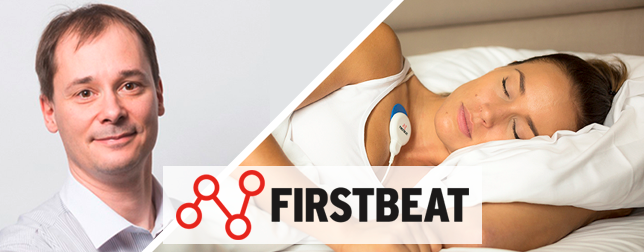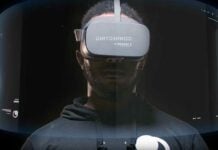Firstbeat is a company that brings cutting-edge physiology, mathematics, and technology together in pursuit of a simple, important goal – to make better health, fitness and performance decisions based on physiology. We wanted to learn more about Firstbeat and its approach and interviewed Joni Kettunen, the CEO & Co-Founder. You will also see him speaking about wearable influences on health and predictive physiological analytic at our upcoming WT | Wearable Technologies Conference in San Francisco on July 11-12.
Can you shortly explain what Firstbeat is about?
Whether you are an elite athlete, working in an office, with your hands, or inspired to make the most of your time with your family, everyone can benefit from insights into how their body experiences, responds and adapts to the world around you. Today, we apply our technology in many recognizable arenas. We are active in corporate wellness and elite sports, where we have products and services under an own brand. We also license our physiological analytics engine to leading wearable brands. In just the past year, Garmin, Huawei, Suunto, Jabra, and Huami Amazfit brought a score of devices to the market that delivers Firstbeat powered insights into stress, recovery, cardiorespiratory fitness in the form of VO2max, the impacts of physical activity, and more.
How can Firstbeat help to understand your body better and to relieve stress?
Practically everything we do at Firstbeat starts with the heart. Closely regulated by your nervous system, your heart responds quickly and continuously to the ever-changing demands of life and environment. By analysing patterns in your heartbeats from one moment to the next, your heart rate variability, Firstbeat can unlock a wealth of personal information. In addition to the effects of physical activity, we can detect the presence and magnitude of stress and recovery reactions in your body from your autonomic nervous system function.
At any given time, you can have over a dozen factors influencing your heartbeat. Through the application of analytics and physiological know-how, Firstbeat decodes your heartbeat data to describe what is happening in your body.
Can you tell more about the Firstbeat Lifestyle Assessment and HRV (heart rate variability), the “secret ingredient” it comes with?
The Firstbeat Lifestyle Assessment is what you might call a professional wearable.
It is a lifestyle screening tool for health coaching services. It has been most successful in corporate wellness programs, especially in Northern Europe and the UK. To date, the service has been performed over a quarter of a million times with very positive results. 82% of participants report they’d improved stress management, sleep quality, or exercise habits because of their experience.
When people are presented with real data from their own lives, it becomes an extraordinarily powerful agent for affecting behavioural change. It is designed for use in professional settings, wherein a wellness or fitness expert provides personal advice and coaching based on the results.
As part of the assessment, participants wear a purposefully designed high-definition HRV recording device for 72-hours as they go about their daily life. Data from the device is then analysed and scientifically transformed into an accurate report detailing views on stress, recovery, sleep quality, physical activity and other lifestyle factors. During the coaching phase, the attending expert uses this report to pinpoint areas of lifestyle in need of improvement with the goal of helping the participant achieving a healthier, happier, more productive life.
Why is HRV so important?
The value of HRV data stems from the richness of the information it contains. The information coded into to your HRV data is directly applicable for improving daily decisions that have a huge impact on your health, fitness, and overall wellbeing.
We’re talking about a phenomenon that holds vital clues towards improving your quality of life.
Analytically, we can transform HRV into a window through which we can observe the constant interplay between the sympathetic and parasympathetic branches of your autonomic nervous system, contributing to stress and recovery.
Your body may cycle between modes of fight-or-flight and rest-and-digest.
It also helps us predict the physiological impact of your activities, and even reveal how long it will take for your body to recover. All this information, and more, is available and personally meaningful because it comes straight from your own body, coded between your heartbeats.
What makes Firstbeat and its solutions stand out in the market?
We founded Firstbeat in 2002, but the project began even earlier through joint research at the University of Jyväskylä in central Finland, so our experience and expertise are certainly big advantages for us.
Beyond those factors, I think a lot of our success stems from our vision and commitment to ensuring that the insights we provide meet essential criteria. The solutions we provide always need to be science-based, or else they will not work. The whole idea of wearables is to provide personalized and meaningful information, presented in a way that allows you to do something that contributes to your performance or health. And this is precisely what our analytics achieve – and as such we help to make valuable products and services that communicate with the users in a meaningful way.
Which hurdles did you have to overcome in the past or are there any challenges you are facing at the moment?
As an analytics company focused on transforming biological data into information people can use, data quality is always at the forefront of our concerns. Wearables are valuable when they give us information about our daily lives. This means capturing and working with data in real-world conditions, a hugely different proposition from working things out in the controlled confines of a laboratory. At Firstbeat, we spend a tremendous amount of time, effort and resources working to ensure our analytics excel even in conditions where the sensor data is not picture perfect.
Do you have some new products in the pipeline? Can you give us a sneak peek?
Working with many of the biggest brands in the wearables industry means knowing how to keep a secret, so I can’t spill the beans on any exciting projects we’re working on in the consumer technology side of things. That said, we had an exciting announcement of our own last month.
At the Firstbeat HRV Summit in London, we revealed the integration of our automatic VO2max Fitness Level detection capabilities with our Firstbeat Lifestyle Assessment service. This means that in addition to the detailed personalized stress, recovery and activity feedback participants can also access their true cardiorespiratory fitness level.
The value of this information is so important that in 2017 the American Heart Association published an official position paper recommending that cardiorespiratory fitness, measurable in terms of VO2max, be regularly assessed and utilized as a clinical vital sign.
So, we’re particularly proud to include that information in our service.
Last but not least! What is the coolest wearable device (besides your own) you have seen so far in 2018?
It isn’t quite a wearable, but at a personal level, I’ve been trying to understand my own genetics better and thinking how what we know about genetic predisposition could be used to enhance and even further personalize the feedback we get from wearables.
Beyond that, I find the trend towards more fashionable wearables inspiring. Ultimately, to succeed wearables need to provide meaningful insight for better decision making, but at the same time, they need to be designed in such a way that people can live with them, be proud to wear them even.
The coolest wearable I’ve used recently is my Garmin Fenix 5. I am using it to track of my training status, VO2max, and acute stress metrics. I rely on it daily for insight into how my training is going, and I find the feedback to be very helpful. Of course, to provide this information, Garmin utilizes our analytics engine, but their development team has done a remarkable job creating a rugged but still elegant device capable of delivering a wealth of useful insight.













